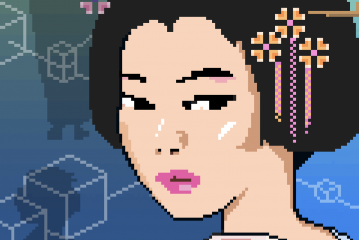Art, today, still has the duty to go beyond the deception of appearances and reveal the secrets of everyday life, the mystery of landscapes and places of our daily routine. Thus, painting can still be a “medium” able to give us a new awareness of the place we live in and of the surrounding artificial nature. Painting is the instrument which enables us to understand the mechanisms of our metropolis; cities made up of suburbs sharing the same “global” features, of glass and steel buildings, and of large department stores. In this sense, the painting of Riccardo Pocci could represent the imaginary indepth-analysis of our cities, an instrument through which the artist digs into the appearances to seize the nervous system of skyscapers and districts. This is done through rigorous and analytic work and images where connectors, bars and steel junctions seem to refer to a lying body widespread in the urban vastness, and rebuildable only through a boundless mosaic of iconic fragments.
Riccardo Pocci’s pictures follow the delicate profiles of edifices which seem to converse with the sky and its light. These profiles multiply in the junctions and in the system of urban structures. They melt into splashes and fluxes of colours which describe and reconstruct the large iron and glass vaults of the railway stations. They vanish in the deceptive blue-tinted reflection of skyscraper window panes.

The artist’s brush has a mysterious quality of metamorphosis because it is able to transform its expressive features according to the different subjects of its poetic themes. It succeeds in transforming the gloomy places into swift spaces gifted with lightness. In fact, the painter’s touch sometimes hits the targets like an arrow and other times portrays buildings with a more plastic “solemnity” founded on the chromatic relationship based on evocative “correspondences” of the blue colour.
Therefore, Pocci’s pictures have two possible interpretations. One, more evident, is based on the relationship between buildings and the environment, between physical space and planned built up space. The other is based on the mysterious analogy which binds man to his architecture and the human figure to its single part.
As a result, the painter’s iconography seems to be suspended between the almost obsolete presence of an industrial world, of an ancient time dominated by metal and concrete, and a post-industrial vision where the city centre seems to lose its importance in front of a “net” of physical and virtual suburbs of which Pocci’s images appear as a possible metaphor. This way, the author’s painting succeeds in mysteriously evocating a sense of physical and conceptual levity, even though it is based on an “heavy” industrial imagery, on the description of a world dominated by steel and cast iron, and on the description of territories crossed by the metallic fragments of fabrications like the veins, arteries and capillaries of our artificial circulatory system. Riccardo Pocci’s vision is therefore able to interchange the recognizable figurative elements with a refined sense of “fiction” in an exquisite “pictorial game” in which the sense of unreality is conceived to play with the dynamics of perception, challenging the eye to perceive the elements which are fundamental to the perception of reality.

The artist’s painting is played on a parallel and almost antithetic vision centred on metropolitan iconography, where the author’s soul seems to be split. On the one hand, the watercolourist stands, who joins the calligraphic subtleties to the age-long tradition of landscape painting and the painting of “journeys”. On the other hand, the “colder” painter stands who, in his production, considers and restyles photography, hyper- realism and the European “New figuration” of the 1960s and 1970s, without neglecting Pop Art, even though he finds a personal balance and expressive formula. Pocci’s watercolours, in fact, are characterized by the liquid conception of chromatic commotion where the tones and colours blend, they vibrate and with a nearly oriental levity, with the contact of water, bloom like mineral flowers to be finally impressed on the paper. His oil painting instead, is often rationally planned in a monochromatic way. In this conception, what he borrows from the artistic repertoire converse with the artist’s desire to document a feeling or a memory. The expanded detail gathers the silent strength of a faraway shadow; sometimes with particular attention to the realistic quality of the figurative result, in a complex vision where the representative codes converse with photography. To all this richness, the artist, through the symbolic strength of a single fragment, adds the density of a compressed moment from memory.

Through the instruments of painting, Pocci works on the essence of the contemporary city, he investigates the environment which receives our physical and mental existence and constantly reflects upon the relations between our habitat and our perception, upon the capacity of the art of proposing a renewing vision of the connections between man and his biological and technological extensions inside the contemporary metropolis.

® All right reserved. You may copy the article giving credit to the original author by citing sources.



